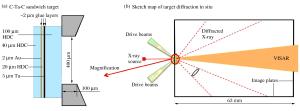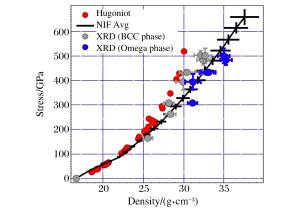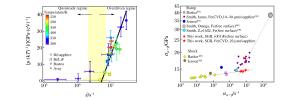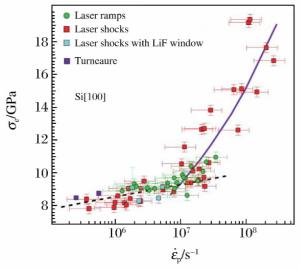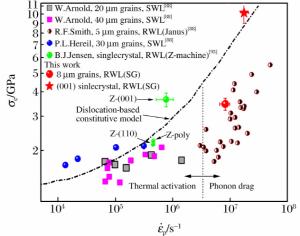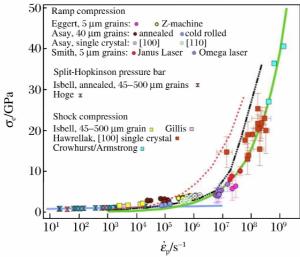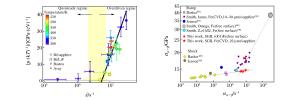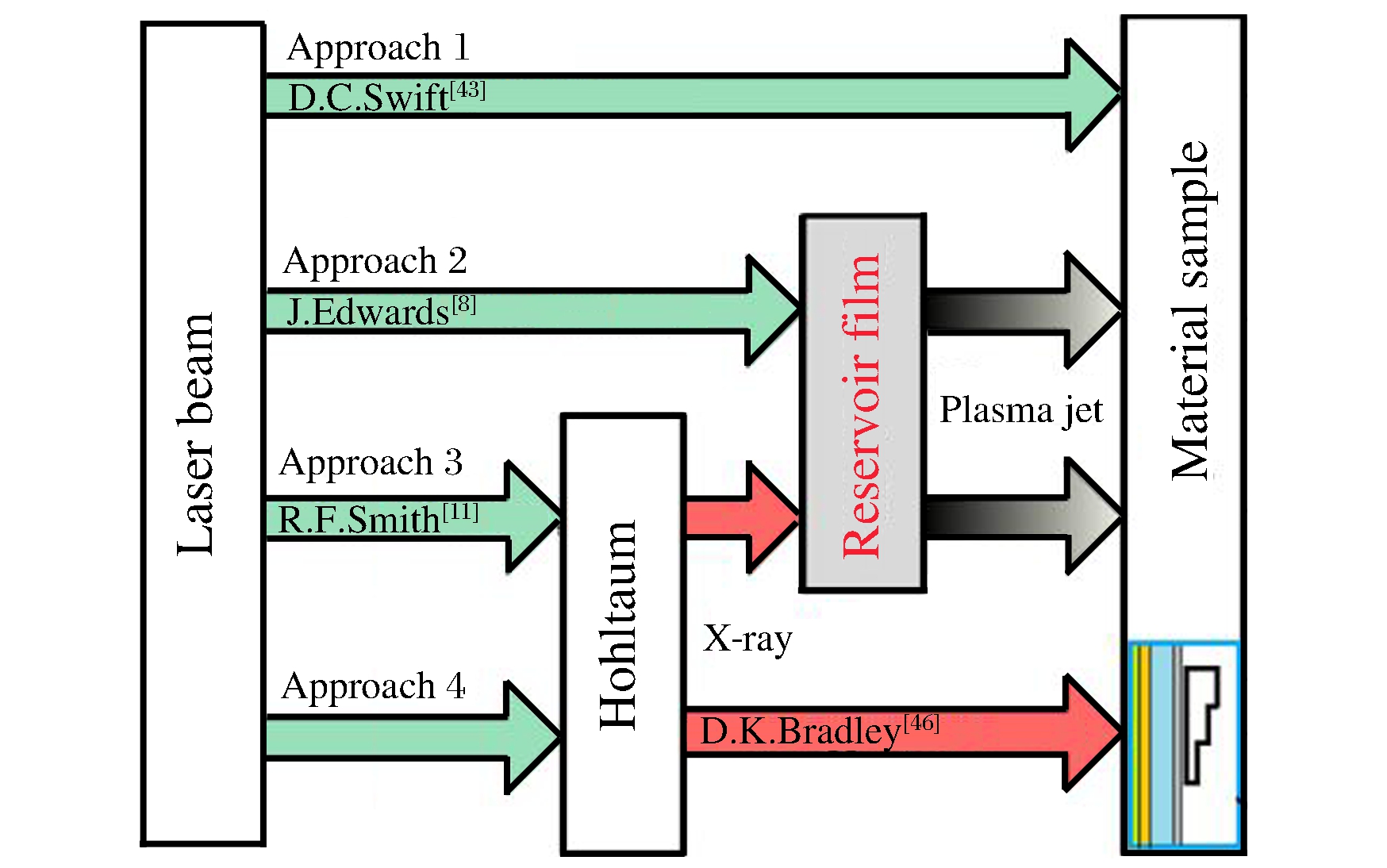| [1] |
Van Kessel C G M, Sigel R. Observation of laser-driven shock waves in solid hydrogen[J]. Physical Review Letters, 1974, 33(17):1020-1023. http://adsabs.harvard.edu/abs/1974PhRvL..33.1020V
|
| [2] |
Salzmann D, Eliezer S, Krumbein A D, et al. Laser-driven shock-wave propagation in pure and layered targets[J]. Physical Review A, 1983, 28(3):1738-1751. http://adsabs.harvard.edu/abs/1983PhRvA..28.1738S
|
| [3] |
Cauble R, Phillion D W, Hooveret T J, et al. Demonstration of 0.75 Gbar planar shocks in x-ray driven colliding foils[J]. Physical Review Letters, 1993, 70(14):2102-2105. http://www.ncbi.nlm.nih.gov/pubmed/10053471
|
| [4] |
Swift D, Hawreliak J, Braun D, et al. Gigabar material properties experiments on NIF and Omega[C]//Elert M L, Buttler W T, Borg J P, et al. Shock Compression of Condensed Matter-2011: Proceedings of the Conference of the American Physical Society Topical Group on Shock Compression of Condensed Matter. Chicago: the American Physical Society, 2011.
|
| [5] |
Lindl J D, Amendt P, Berger R L, et al. The physics basis for ignition using indirect-drive targets on the National Ignition Facility[J]. Physics of Plasmas, 2004, 11(2):339. http://www.tandfonline.com/servlet/linkout?suffix=CIT0002&dbid=16&doi=10.1080%2F09500340.2015.1075619&key=10.1063%2F1.1578638
|
| [6] |
Munro D H, Celliers P M, Collins G W, et al. Shock timing technique for the National Ignition Facility[J]. Physics of Plasmas, 2001, 8(5):2245. doi: 10.1063/1.1347037
|
| [7] |
Shigemori K, Shimizu K, Nakamoto Y, et al. Multiple shock compression of diamond foils with a shaped laser pulse over 1 TPa[J]. Journal of Physics: Conference Series, 2008, 112(4):042023. http://adsabs.harvard.edu/abs/2008JPhCS.112d2023S
|
| [8] |
Edwards J, Lorenz K T, Remington B A, et al. Laser-driven plasma loader for shockless compression and acceleration of samples in the solid state[J]. Physical Review Letters, 2004, 92(7):075002. http://www.ncbi.nlm.nih.gov/pubmed/14995863
|
| [9] |
Li Mu, Zhang Hong-ping, Sun Cheng-wei, et al. Numerical analysis of laser-driven reservoir dynamics for shockless loading[J]. Journal of Applied Physics, 2011, 109(9):093525. http://ieeexplore.ieee.org/xpls/abs_all.jsp?arnumber=5770336
|
| [10] |
Hawreliak J, Colvin J, Eggert J, et al. Modeling planetary interiors in laser based experiments using shockless compression[J]. Astrophysics and Space Science, 2007, 307(1/2/3):285-289. doi: 10.1007/s10509-007-9385-z
|
| [11] |
Smith R F, Eggert J H, Jankowski A, et al. Stiff response of aluminum under ultrafast shockless compression to 110 GPa[J]. Physical Review Letters, 2007, 98(6):065701. http://europepmc.org/abstract/MED/17358956
|
| [12] |
Smith R F, Pollaine S M, Moon S J, et al. High planarity x-ray drive for ultrafast shockless-compression experiments[J]. Physics of Plasmas, 2007, 14(5):057105. doi: 10.1063/1.2712450
|
| [13] |
Miyanishi K, Ozaki N, Brambrink E, et al. Characterization of laser-driven ultrafast shockless compression using gold targets[J]. Journal of Applied Physics, 2014, 116(4):043521 doi: 10.1063/1.4891802
|
| [14] |
Eggert J H, Hicks D G, Celliers P M, et al. Melting temperature of diamond at ultrahigh pressure[J]. Nature Physics, 2010, 6(1):40-43. http://www.nature.com/nphys/journal/v6/n1/abs/nphys1438.html
|
| [15] |
Spaulding D K, McWilliams R S, Jeanloz R, et al. Evidence for a phase transition in silicate melt at extreme pressure and temperature conditions[J]. Physical Review Letter, 2012, 108(6):065701. http://www.ncbi.nlm.nih.gov/pubmed/22401087
|
| [16] |
McWilliams R S, Spaulding D K, Eggert J H, et al., Phase transformations and metallization of magnesium oxide at high pressure and temperature[J]. Science, 2012, 338(6112):1330-1333. http://www.bionity.com/en/publications/495318/report-phase-transformations-and-metallization-of-magnesium-oxide-at-high-pressure-and-temperature.html
|
| [17] |
Luo S N, Swift D C, Tierney T E, et al. Laser-induced shock waves in condensed matter: Some techniques and applications[J]. High Pressure Research, 2004, 24(4):409-422. http://adsabs.harvard.edu/abs/2004HPR....24..409L
|
| [18] |
Kalantar D H, Belak J F, Collins G W, et al. Direct observation of the α-ε transition in shock-compressed iron via nanosecond x-ray diffraction[J]. Physical Review Letters, 2005, 95(7):075502. http://adsabs.harvard.edu/cgi-bin/nph-data_query?bibcode=2005PhRvL..95g5502K&db_key=PHY&link_type=EJOURNAL
|
| [19] |
Gotchev O V, Chang P Y, Knauer J P, et al. Laser-driven magnetic-flux compression in high-energy-density plasmas[J]. Physical Review Letter, 2009, 103(21):215004. http://www.ncbi.nlm.nih.gov/pubmed/20366046
|
| [20] |
Collins G. Physics of dense matter[C]//Proceedings of the 2013 HEDP Summer School. Ohio State University, 2013.
|
| [21] |
Benuzzi A, Löwer T, Koenig M, et al. Indirect and direct laser driven shock waves and applications to copper equation of state measurements in the 10-40 Mbar pressure range[J]. Physical Review E, 1996, 54(2):2162-2165. http://www.ncbi.nlm.nih.gov/pubmed/9965306
|
| [22] |
Cottet F, Romain J P, Fabbro R, et al. Ultrahigh-pressure laser-driven shock-wave experiments at 0.26 μm wavelength[J]. Physical Review Letters, 1984, 52(21):1884-1886. http://adsabs.harvard.edu/abs/1984PhRvL..52.1884C
|
| [23] |
Trainor R J, Holmes N C, Anderson R A, et al. Shock wave pressure enhancement using short wavelength (0.35 μm) laser irradiation[J]. Applied Physics Letters, 1983, 43(6):542-544. doi: 10.1063/1.94412
|
| [24] |
Fu Si-zu, Huang Xiu-guang, Ma Min-xun, et al. Analysis of measurement error in the experiment of laser equation of state with impedance-match way and the Hugoniot data of Cu up to ~2.24 TPa with high precision[J]. Journal of Applied Physics, 2007, 101(4):043517. http://ieeexplore.ieee.org/xpls/abs_all.jsp?arnumber=4942823
|
| [25] |
Celliers P M, Collins G W, Silva L B D, et al. Accurate measurement of laser-driven shock trajectories with velocity interferometry[J]. Applied Physics Letters, 1998, 73(10):1320. http://ieeexplore.ieee.org/xpls/abs_all.jsp?arnumber=4898858
|
| [26] |
Bradley D K, Eggert J H, Hicks D G, et al. Shock compressing diamond to a conducting fluid[J]. Physical Review Letters, 2004, 93(19):195506. http://www.ncbi.nlm.nih.gov/pubmed/15600850
|
| [27] |
Celliers P M, Bradley D K, Collins G W, et al. Line-imaging velocimeter for shock diagnostics at the OMEGA laser facility[J]. Review of Scientific Instruments, 2004, 75(11):4916. http://ieeexplore.ieee.org/xpls/abs_all.jsp?arnumber=5011353
|
| [28] |
Celliers P M, Collins G W, Hicks D G, et al. Electronic conduction in shock-compressed water[J]. Physics of Plasmas, 2004, 11(8):41-44. doi: 10.1063/1.1758944
|
| [29] |
Hicks D G, Boehly T R, Celliers P M, et al. Shock compression of quartz in the high-pressure fluid regime[J]. Physics of Plasmas, 2005, 12(8):082702. doi: 10.1063/1.2009528
|
| [30] |
Miller J E, Boehly T R, Melchior A, et al. Streaked optical pyrometer system for laser-driven shock-wave experiments on OMEGA[J]. Review of Scientific Instruments, 2007, 78(3):034903. doi: 10.1063/1.2712189
|
| [31] |
Hicks D G, Boehly T R, Celliers P M, et al. Laser-driven single shock compression of fluid deuterium from 45 to 220 GPa[J]. Physical Review B, 2009, 79(1):014112. http://adsabs.harvard.edu/abs/2009PhRvB..79a4112H
|
| [32] |
Jeanloz R, Celliers P M, Collins G W, et al. Achieving high-density states through shock-wave loading of precompressed samples[J]. Proceedings of the National Academy of Sciences, 2007, 104(22):9172-9177. doi: 10.1073/pnas.0608170104
|
| [33] |
Eggert J, Brygoo S, Loubeyre P, et al. Hugoniot data for helium in the ionization regime[J]. Physical Review Letters, 2008, 100(12):124503. http://www.ncbi.nlm.nih.gov/pubmed/18517873
|
| [34] |
Loubeyre P, Brygoo S, Eggert J, et al. Extended data set for the equation of state of warm dense hydrogen isotopes[J]. Physical Review B, 2012, 86(14):144115. http://adsabs.harvard.edu/abs/2012PhRvB..86n4115L
|
| [35] |
Brygoo S, Henry E, Loubeyre P, et al. Laser-shock compression of diamond and evidence of a negative-slopemelting curve[J]. Nature Materials, 2007, 6(4): 274-281. http://europepmc.org/abstract/MED/17384637
|
| [36] |
Knudson M D, Desjarlais M P. Adiabatic release measurements in α-quartz between 300 and 1200 GPa: Characterization of α-quartz as a shock standard in the multimegabar regime[J]. Physical Review B, 2013, 88(18):184107. http://adsabs.harvard.edu/abs/2013PhRvB..88r4107K
|
| [37] |
Ozaki N, Sano T, Ikoma M, et al. Shock Hugoniot and temperature data for polystyrene obtained with quartz standard[J]. Physics of Plasmas, 2009, 16(6):062702. doi: 10.1063/1.3152287
|
| [38] |
Knudson M D, Desjarlais M P. Shock compression of quartz to 1.6 TPa: Redefining a pressure standard[J]. Physical Review Letters, 2009, 103(22):225501. http://www.ncbi.nlm.nih.gov/pubmed/20366104
|
| [39] |
Eggert J H. Materials at extreme compression[R]. Report No. LLNL-CONF-655773, 2014.
|
| [40] |
孙承纬, 赵剑衡, 王桂吉, 等.磁驱动准等熵平面压缩和超高速飞片发射实验技术原理、装置及应用[J].力学进展, 2012, 42(2):206-218. http://d.wanfangdata.com.cn/Periodical/lxjz201202008Sun Cheng-wei, Zhao Jian-heng, Wang Gui-ji, et al. Progress in magentic loading techniques for isentropic compression experiments and ultra-high velocity flyer launching[J]. Advances in Mechanics, 2012, 42(2):206-218. http://d.wanfangdata.com.cn/Periodical/lxjz201202008
|
| [41] |
Smith R F, Eggert J H, Jeanloz R, et al. Ramp compression of diamond to five terapascals[J]. Nature, 2014, 511(7509):330-333. http://europepmc.org/abstract/MED/25030170
|
| [42] |
Cauble R, Reisman D B, Asay J R, et al. Isentropic compression experiments to 1 Mbar using magnetic pressure[J]. Joural of Physics: Condensed Matter, 2002, 14:10821-10824. http://www.ingentaconnect.com/search/article?option1=tka&value1=Isentropic+compressibilities&pageSize=10&index=2
|
| [43] |
Swift D C, Johnson R P. Quasi-isentropic compression by ablative laser loading: Response of materials to dynamic loading on nanosecond time scales[J]. Physical Review, 2005, 71(6):066401. http://www.ncbi.nlm.nih.gov/pubmed/16089874
|
| [44] |
Amadou N, Brambrink E, Benuzzi-Mounaix A N, et al. Direct laser-driven ramp compression studies of iron: A first step toward the reproduction of planetary core conditions[J]. High Energy Density Physics, 2013, 9(2):243-246. http://www.sciencedirect.com/science/article/pii/S1574181813000098
|
| [45] |
Koenig M, Benuzzi-Mounaix A, Brambrink E, et al. Simulating earth core using high energy lasers[J]. High Energy Density Physics, 2000, 6(2):210-214. http://www.sciencedirect.com/science/article/pii/S1574181809001256
|
| [46] |
Bradley D K, Eggert J H, Smith R F, et al. Diamond at 800 GPa[J]. Physical Review Letters, 2009, 102(7):075503. http://europepmc.org/abstract/MED/19257686
|
| [47] |
Xue Quan-xi, Wang Zhe-bin, Jiang Shao-en, et al. Laser-direct-driven quasi-isentropic experiments on aluminum[J]. Physics of Plasmas, 2014, 21(7):072709. doi: 10.1063/1.4890851
|
| [48] |
Wang J, Smith R F, Eggert J H, et al. Ramp compression of iron to 273 GPa[J]. Journal of Applied Physics, 2013, 114(2):023513. doi: 10.1063/1.4813091
|
| [49] |
Wang J, Smith R F, Coppari F, et al. Ramp compression of magnesium oxide to 234 GPa[J]. Journal of Physics: Conference Series, 2014, 500(6):062002. http://meetings.aps.org/link/BAPS.2013.SHOCK.H5.4
|
| [50] |
Eggert J. Ramp-compression experiments on tantalum at the NIF and Omega lasers[R]. Report Number: LLNL-CONF-490363, 2011.
|
| [51] |
Eggert J. Overview of NIF TARDIS shots[R]. Report Number: LLNL-CONF-653683, 2014.
|
| [52] |
Swift D C, Kraus R G, Loomis E N, et al. Shock formation and the ideal shape of ramp compression waves[J]. Physical Review E, 2008, 78:066115. http://europepmc.org/abstract/MED/19256913
|
| [53] |
Jin Yun-sheng, Sun Cheng-wei, Zhao Jian-heng, et al. Optimization of loading pressure waveforms for piston driven isentropic compression[J]. Journal of Applied Physics, 2014, 115(24):243506. http://ieeexplore.ieee.org/xpl/login.jsp?tp=&arnumber=6846238&url=http%3A%2F%2Fieeexplore.ieee.org%2Fstamp%2Fstamp.jsp%3Ftp%3D%26arnumber%3D6846238
|
| [54] |
Xue Quan-xi, Wang Zhe-bin, Jiang Shao-en, et al. Characteristic method for isentropic compression simulation[J]. AIP Advances, 2014, 4(5):057127. doi: 10.1063/1.4880039
|
| [55] |
Shu Hua, Fu Si-zu, Huang Xiu-guang, et al. Plastic behavior of aluminum in high strain rate regime[J]. Journal of Applied Physics, 2014, 116(3):033506. http://ieeexplore.ieee.org/xpls/abs_all.jsp?arnumber=6857956
|
| [56] |
Lorenz K T, Edwards M J, Glendinning S G, et al. Accessing ultrahigh-pressure, quasi-isentropic states of matter[J]. Physics of Plasmas, 2005, 12(5):056309. doi: 10.1063/1.1873812?TRACK=RSS
|
| [57] |
Lorenz K T, Edwards M J, Jankowski A F, et al. High pressure, quasi-isentropic compression experiments on the Omega laser[J]. High Energy Density Physics, 2006, 2(3/4):113-125. http://www.sciencedirect.com/science/article/pii/S1574181806000255
|
| [58] |
Smith R F, Lorenz K T, Ho D, et al. Graded-density reservoirs for accessing high stress low temperature material states[J]. Astrophysics and Space Science, 2007, 307(1/2/3):269-272. doi: 10.1007/978-1-4020-6055-7_49
|
| [59] |
Park H, Remington B A, Braun D, et al. Quasi-isentropic material property studies at extreme pressures: From Omega to NIF[J]. Journal of Physics: Conference Series, 2008, 112(4):042024. http://digital.library.unt.edu/ark:/67531/metadc898746/
|
| [60] |
Yaakobi B, Boehly T R, Sangster T C, et al. Extended x-ray absorption fine structure measurements of quasi-isentropically compressed vanadium targets on the OMEGA laser[J]. Physics of Plasmas, 2008, 15(6):062703. doi: 10.1063/1.2938749
|
| [61] |
Swift D C, Hawreliak J, El-Dasher B, et al. Flow stress of V, Mo, Ta, and W on nanosecond time scales[C]//Elert M, Furnish M D, Anderson W W, et al. Shock Compression of Condensed Matter 2009: Proceedings of the American Physical Society Topical Group on Shock Compression of Condensed Matter. Nashville (Tennessee): the American Physical Society, 2009.
|
| [62] |
Park H S, Remington B A, Becker R C, et al. Viscous Rayleigh-Taylor instability experiments at high pressure and strain rate[J]. Physical Review Letters, 2010, 104(13):135504. http://europepmc.org/abstract/MED/21231088
|
| [63] |
Park H S, Remington B A, Becker R C, et al. Strong stabilization of the Rayleigh-Taylor instability by material strength at megabar pressures[J]. Physics of Plasmas, 2010, 17(5):056314-9. doi: 10.1063/1.3363170
|
| [64] |
Smith R F, Eggert J H, Saculla M D, et al. Ultrafast dynamic compression technique to study the kinetics of phase transformations in bismuth[J]. Physical Review Letters, 2008, 101(6):065701. doi: 10.1103/physrevlett.101.065701
|
| [65] |
Prisbrey S T, Park H S, Remington B A, et al. Tailored ramp-loading via shock release of stepped-density reservoirs[J]. Physics of Plasmas, 2012, 19(5):056311. doi: 10.1063/1.3699361
|
| [66] |
Brown J L, Alexander C S, Asay J R, et al. Extracting strength from high pressure ramp-release experiments[J]. Journal of Applied Physics, 2013, 114(22):223518. doi: 10.1063/1.4847535
|
| [67] |
Brown J L, Alexander C S, Asay J R, et al. Flow strength of tantalum under ramp compression to 250 GPa[J]. Journal of Applied Physics, 2014, 115(4):043530. http://ieeexplore.ieee.org/xpl/articleDetails.jsp?arnumber=6730879
|
| [68] |
Vogler T J, Ao T, Asay J R. High-pressure strength of aluminum under quasi-isentropic loading[J]. International Journal of Plasticity, 2009, 25(4):671-694. http://www.sciencedirect.com/science/article/pii/S0749641908001782
|
| [69] |
Kalantar D H, Chandler E A, Colvin J D, et al. Transient x-ray diffraction used to diagnose shock compressed Si crystals on the Nova laser[J]. Review of Scientific Instruments, 1999, 70(1):629-632.
|
| [70] |
Loveridge-Smith A, Allen A, Belak J, et al. Anomalous elastic response of silicon to uniaxial shock compression on nanosecond time scales[J]. Physical Review Letters, 2001, 86(11):2349-2352. http://www.ncbi.nlm.nih.gov/pubmed/11289926
|
| [71] |
Kalantar D H, Allen A M, Gregori F, et al. Laser driven high pressure, high strain-rate materials experiments[C]//AIP Conference Proceedings: Shock Compression of Condensed Matter. Atlanta: the American Physical Society, 2002, 620(1): 615-618.
|
| [72] |
Kalantar D H, Belak J, Bringa E, et al. High-pressure, high-strain-rate lattice response of shocked materials[J]. Physics of Plasmas, 2003, 10(5):1569-1576. doi: 10.1063/1.1565118
|
| [73] |
Hawreliak J, Colvin J D, Eggert J H, et al. Analysis of the x-ray diffraction signal for the α-ε transition in shock-compressed iron: Simulation and experiment[J]. Physical Review B, 2006, 74(18):184107. http://scitation.aip.org/getabs/servlet/GetabsServlet?prog=normal&id=PRBMDO000074000018184107000001&idtype=cvips&gifs=Yes
|
| [74] |
Hawreliak J A, Kalantar D H, Stölken J S, et al. High-pressure nanocrystalline structure of a shock-compressed single crystal of iron[J]. Physical Review B, 2008, 78(22):220101. http://adsabs.harvard.edu/abs/2008PhRvB..78v0101H
|
| [75] |
Rygg J R, Eggert J H, Lazicki A E, et al. Powder diffraction from solids in the terapascal regime[J]. Review of Scientific Instruments, 2012, 83(11):113904. http://ieeexplore.ieee.org/xpls/abs_all.jsp?arnumber=6365144
|
| [76] |
Higginbotham A, Patel S, Hawreliak J A, et al. Single photon energy dispersive x-ray diffraction[J]. Review of Scientific Instruments, 2014, 85(3):033906. http://ieeexplore.ieee.org/xpl/articleDetails.jsp?arnumber=6778699
|
| [77] |
Knudson M D, Desjarlais M P, Dolan D H. Shock-wave exploration of the high-pressure phases of carbon[J]. Science, 2008, 322(19):1822. http://meetings.aps.org/Meeting/SHOCK09/Event/105388
|
| [78] |
Hicks D G, Boehly T R, Celliers P M, et al. High-precision measurements of the diamond Hugoniot in and above the melt region[J]. Physical Review B, 200, 78(17):174102.
|
| [79] |
Ping Y, Coppari F, Hicks D G, et al. Solid iron compressed up to 560 GPa[J]. Physical Review Letters, 2013, 111(6):065501. http://europepmc.org/abstract/med/23971582
|
| [80] |
Mallozzi P J, Schwerzel R E, Epstein H M, et al. Fast extended-x-ray-absorption-fine-structure spectroscopy with a laser-produced x-ray pulse[J]. Physical Review A, 1981, 23(2):824-828. http://prola.aps.org/abstract/PRA/v23/i2/p824_1
|
| [81] |
Meyerhofer D D, Yaakobi B, Marshall F J, et al. EXAFS detection of laser shock heating[J]. Bulletin of the American Physical Society (USA), 2001, 46(8):294. http://www.opticsinfobase.org/abstract.cfm?uri=HFSW-2001-WC2
|
| [82] |
Yaakobi B, Marshall F J, Boehly T R, et al. Extended x-ray absorption fine-structure experiments with a laser-imploded target as a radiation source[J]. Journal of the Optical Society of America: B, 2003, 20(1):238-245. http://scitation.aip.org/getabs/servlet/GetabsServlet?prog=normal&id=VIRT05000002000001000145000001&idtype=cvips&gifs=Yes
|
| [83] |
Yaakobi B, Meyerhofer D D, Boehly T R, et al. Extended x-ray absorption fine structure measurements of laser shocks in Ti and V and phase transformation in Ti[J]. Physics of Plasmas, 2004, 11(5):2688-2695. doi: 10.1063/1.1646673
|
| [84] |
Yaakobi B, Meyerhofer D D, Boehly T R, et al. Dynamic EXAFS probing of laser-driven shock waves and crystal-phase transformations[J]. Physical Review Letters, 2004, 92(9):095504. http://www.opticsinfobase.org/abstract.cfm?uri=FiO-2004-FTuN4
|
| [85] |
Yaakobi B, Boehly T R, Meyerhofer D D, et al. EXAFS measurement of iron bcc-to-hcp phase transformation in nanosecond-laser shocks[J]. Physical Review Letters, 2005, 95(7):075501. http://europepmc.org/abstract/MED/16196790
|
| [86] |
Smith R F, Eggert J H, Swift D C, et al. Time-dependence of the alpha to epsilon phase transformation in iron[J]. Journal of Applied Physics, 2013, 114(22):223507. http://ieeexplore.ieee.org/xpl/articleDetails.jsp?arnumber=6708798
|
| [87] |
Smith R F, Minich R W, Rudd R E, et al. Orientation and rate dependence in high strain-rate compression of single-crystal silicon[J]. Physical Review B, 2012, 86(24):245204. doi: 10.1103/PhysRevB.86.245204
|
| [88] |
Smith R F, Eggert J H, Rudd R E, et al. High strain-rate plastic flow in Al and Fe[J]. Journal of Applied Physics, 2011, 110(12):123515. doi: 10.1063/1.3670001
|
| [89] |
Coppari F, Smith R F, Eggert J H, et al. Experimental evidence for a phase transition in magnesium oxide at exoplanet pressures[J]. Nature Geoscience, 2013, 6(11):926-929. http://www.nature.com/ngeo/journal/v6/n11/abs/ngeo1948.html
|
| [90] |
Pang Wei-wei, Zhang Ping, Zhang Guang-cai, et al. Morphology and growth speed of hcp domains during shock-induced phase transition in iron[J]. Nature Scientific Reports, 2014, 4:03628. http://www.nature.com/articles/srep03628
|
| [91] |
Yu Ji-dong, Wang Wen-jiang, Wu Qiang. Nucleation and growth in shock-induced phase transitions and how they determine wave profile features[J]. Physical Review Letters, 2012, 109(11):115701. http://europepmc.org/abstract/MED/23005645
|
| [92] |
Smith R F, Minich R W, Rudd R E, et al. Orientation and rate dependence in high strain-rate compression of single-crystal silicon[J]. Physical Review B, 2012, 86(24):245204. doi: 10.1103/PhysRevB.86.245204
|
| [93] |
Jensen B J, Rigg P A, Knudson M D, et al. Dynamic compression of iron single crystals[C]//Furnish M D, Elert M, Russell T P, et al. Shock Compression of Condensed Matter-2005: Proceedings of the Conference of the American Physical Society Topical Group on Shock Compression of Condensed Matter. Baltimore, Maryland (USA): American Institute of Physics, 2006, 845(1): 232-235.
|






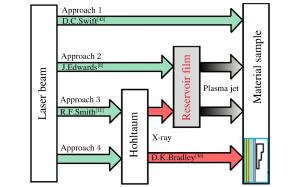
 下载:
下载:
